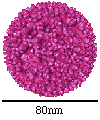Introduction
The Reoviridae family was proposed in 1959 by Sabin to represent
respiratory enteric orphan viruses, as they were commonly found in the
respiratory and enteric tract, but were not associated with any disease in
humans. This name was later found to be misleading as Reoviruses can
cause
significant disease in humans. The Reoviridae family is composed of 9
genera. The genera Rotavirus, Coltivirus, and
Orthoreovirus contain human viruses. Rotaviruses are the major cause of
infantile diarrhea and are responsible for almost a million childhood
deaths per year, especially in underdeveloped countries. Colitvirus causes
Colorado Tick fever, a dengue-like illness as well as encephalitis, in
North America. Orthoreoviruses have not yet been linked to specific
disease state, although there may be some connection
between them and upper respiratory symptoms.
 Rotavirus
Rotavirus
Reoviridae is a family of viruses which are characterized by a
double-stranded RNA genome, a spherical shape, and a non-enveloped
virion.
Unique among viruses, Reoviridae have an outer and inner icosahedral
capsid that
surround an inner core containing necessary enzymes for mRNA synthesis,
including RNA polymerase. It has a segmented genome (Orthoreoviruses
have 10, Rotaviruses have 11, and Colitviruses have 12
segments). The genome codes for structural and non-structural
genes and can readily reassort, a characteristic exploited by those
developing vaccines. They usually have a total size of 18-27
kilobase pairs.
Back

